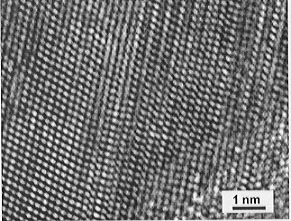

Diamond has outstanding properties such as extreme hardness, high heat conductivity and electrical resistivity. Many techniques have been developed for the synthesis of diamonds: dynamic (shock) and static (multianvil) high-pressure techniques and chemical vapor deposition (CVD) involving a plasma. These techniques are primarily designed to yield high-quality diamonds with industrial applications and are therefore not perfectly suitable to simulate natural formation processes of diamonds such as meteorite impact, condensation from the solar nebula, and growth in the Earth's mantle.
To address the question of the solid-state formation of diamond and the stability of other high-pressure carbon polytypes, well-crystallized single crystal graphite has been subjected to quasi-hydrostatic pressures of 25 GPa in a 1000 tonne multianvil apparatus. Temperatures were 1000°C and 1500°C for run times between 5 and 15 minutes. As in nature, the experiments were carried out in the absence of a classic solvent-catalyst (e.g., transition metals such as Fe, Co...) and may thus be relevant for the solid-state transformation of graphite in deep subduction zones and in impacts events. Recovered samples were studied by X-ray diffraction (XRD) and transmission electron microscopy (TEM).
X-ray powder diffraction confirms the almost complete conversion of graphite into diamond. The diamonds are, however, of poor quality since X-ray diffraction patterns display only broad, diffuse peaks. Close to the most intense diamond peak (i.e. 111 at 2.06 Å), distinct scattering contributions are observed at about 2.19 Å, which could be interpreted to result from a hexagonal high-pressure carbon polymorph, known as the mineral 2H lonsdaleite. In this mineral, the stacking sequence of carbon layers is hexagonal (ABAB...) along the c-axis, whereas in diamond it is cubic (ABCABC...) along the <111> directions.
TEM investigations of the synthesized diamonds reveal an epitactic relationship of diamond and graphite with (111)Dia parallel to (0001)Gra. High resolution TEM shows the presence of a high density of 60° partial dislocations and numerous stacking faults parallel to the (111) plane. The stacking sequence is random with either missing or extra planes (i.e., the stacking faults are of intrinsic and extrinsic type). Microtwins are closely related to such stacking faults as they can be regarded as a pair of stacking faults with the number of layers (n) with correct stacking in between the faults n>1. Such microtwins are rarely observed in the synthesized diamonds and regions with extended stacking sequences corresponding to lonsdaleite are even absent (Fig. 3.2-15).
 |
Fig. 3.2-15:
High-resolution TEM image of defect-rich diamond synthesized at 25 GPa and 1000°C. |
These results provide evidence that the diamonds have a very disordered stacking sequence and, in contrast to previous interpretations, do not contain extended crystals of lonsdaleite. The X-ray diffraction peak observed at 2.19 Å has therefore to be regarded as a result of diffuse scattering perpendicular to the stacking faults.

Tel: +49-(0) 921 55 3700 / 3766, Fax: +49-(0) 921 55 3769, E-mail: bayerisches.geoinstitut(at)uni-bayreuth.de
 Previous page
Previous page